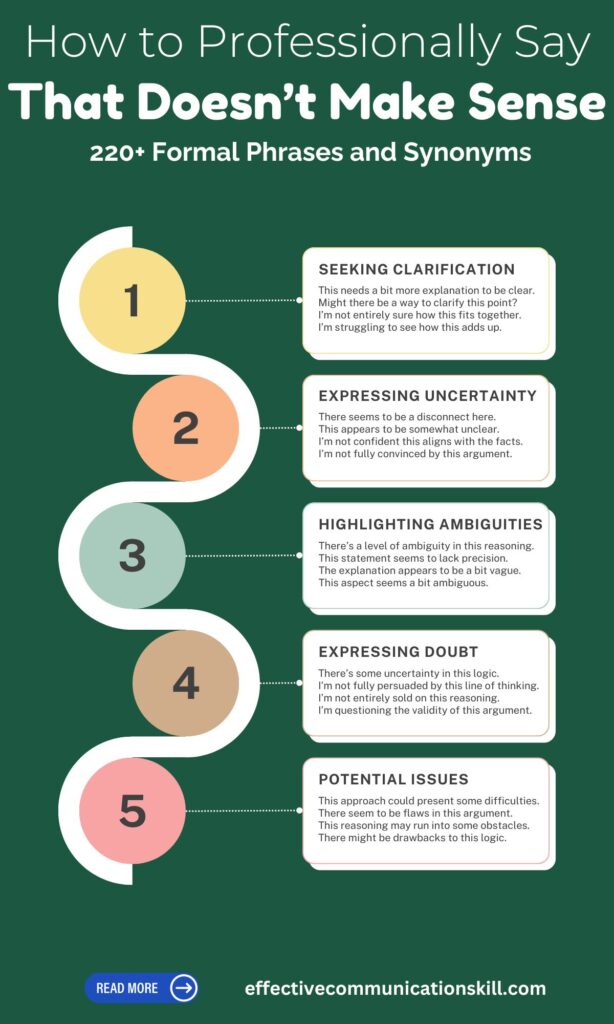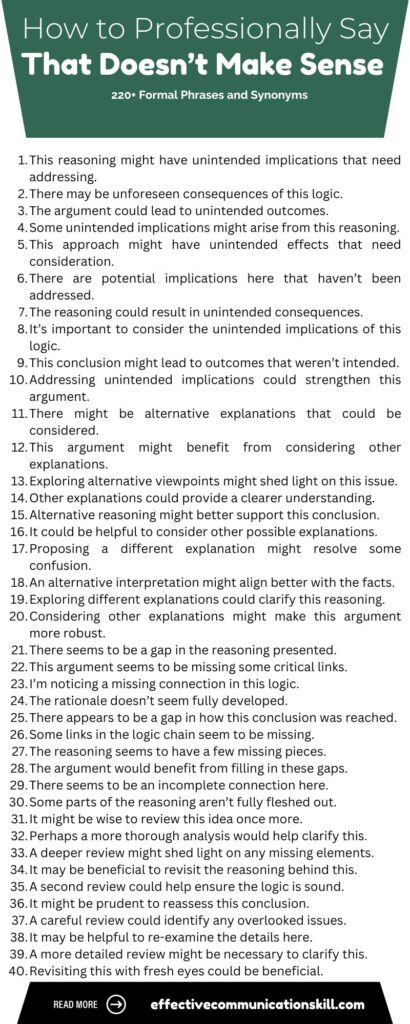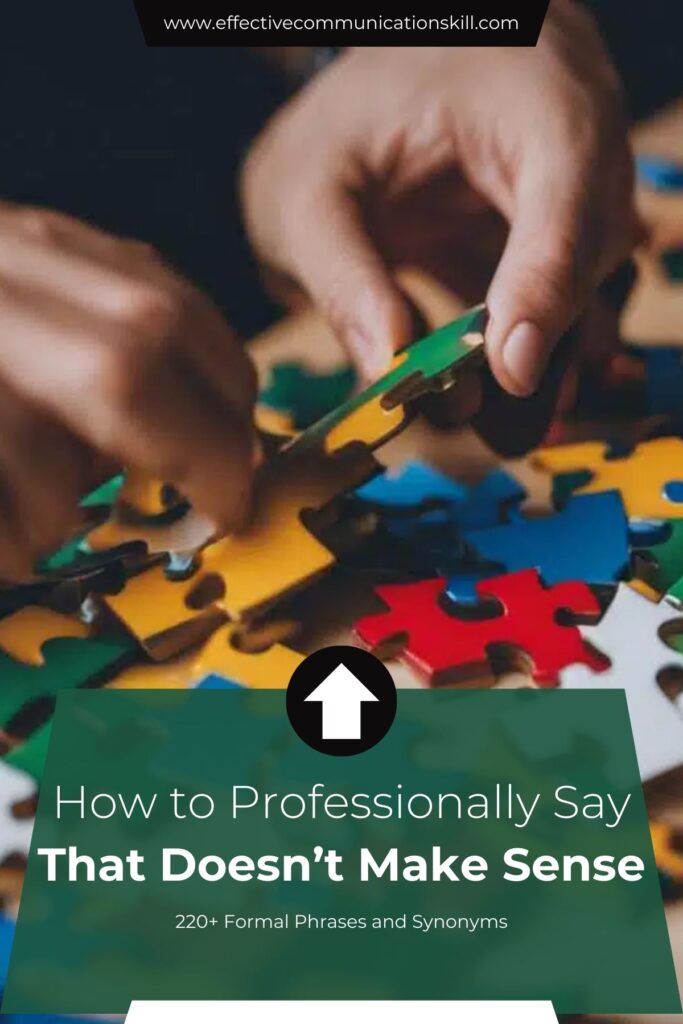How to Professionally Say That Doesn’t Make Sense
In professional settings, clear and constructive communication is key to maintaining productive relationships and achieving desired outcomes.
However, there are moments when you encounter ideas, suggestions, or statements that simply don’t add up. In these situations, directly saying “that doesn’t make sense” might come off as harsh or dismissive. Yet, it’s important to address these misunderstandings or errors without causing offense.
How to Professionally Say None of Your Business – Learning how to professionally say that doesn’t make sense can enhance your ability to navigate complex conversations, clarify points, and maintain a positive tone. Whether you’re in a meeting, responding to an email, or engaged in a one-on-one discussion, using the right language can help you express doubt or confusion without shutting down the conversation.
This blog post explores practical ways to communicate these moments of uncertainty effectively and with professionalism.

How to Professionally Say That Doesn’t Make Sense
Implementing these tips can help navigate saying that doesn’t make sense politely with clarity and respect.
Seek Clarification Before Critique
Before jumping to conclusions, ask for more information. This approach ensures that you’re not missing any key details and shows that you’re engaged and willing to understand.
For instance, if a colleague proposes a new strategy that seems flawed, you might say, “Could you walk me through that idea again? I want to make sure I’m fully understanding your approach.” This not only gives them a chance to explain further but also opens the door for a more constructive discussion.
Offer a Polite Rephrasing
Sometimes, the way something is phrased can make it difficult to understand. Instead of saying it doesn’t make sense, try rephrasing the statement and then seek confirmation.
For example, in response to a confusing email, you could reply, “If I’m understanding correctly, you’re suggesting that we take this approach because of X and Y. Is that right?” This method helps to clarify the message while also providing the other person an opportunity to correct any misunderstandings.
Express Your Confusion as a Shared Challenge
Frame your confusion as something that both of you need to work through together. This collaborative approach can soften the impact of questioning someone’s logic.
For instance, in a meeting, you might say, “I’m having a bit of trouble connecting the dots here. Can we revisit this part of the plan to make sure we’re all on the same page?” This makes it clear that your goal is to reach mutual understanding, rather than simply pointing out flaws.
Redirect the Focus to Outcomes or Goals
If something doesn’t make sense in terms of the bigger picture, redirect the conversation to focus on the intended outcomes.
For example, if a team member suggests a course of action that seems off-track, you could respond with, “I’m trying to see how this aligns with our overall objectives. Can we explore how this approach will help us achieve our goals?” This strategy encourages the person to reconsider their suggestion in the context of the broader goals, which can lead to more coherent and strategic thinking.
Use Questions to Highlight Inconsistencies
Instead of directly stating that something doesn’t make sense, ask questions that gently point out the inconsistencies.
For instance, if a proposal seems contradictory, you could ask, “How does this fit with our earlier discussions on [topic]?” or “Can you help me understand how these two points align?” This encourages the other person to think more critically about their proposal and allows them to identify and correct any issues on their own.
25 Formal Synonyms for That Doesn’t Make Sense
These Polite synonyms for that doesn’t make sense provide various ways to express that something is unclear or illogical, offering a range of options for maintaining professionalism in your responses. Choose the term that best fits the context of your discussion.
- That reasoning seems unclear.
- This explanation lacks clarity.
- The logic appears inconsistent.
- I’m struggling to follow this reasoning.
- The connection here is not entirely clear.
- This argument seems a bit disjointed.
- The rationale is somewhat perplexing.
- This interpretation seems off.
- The reasoning doesn’t fully align.
- I’m having difficulty comprehending this.
- The thought process appears fragmented.
- This point is a bit ambiguous.
- The logic isn’t entirely cohesive.
- I’m not fully grasping the intent here.
- The explanation seems a bit convoluted.
- This argument is somewhat contradictory.
- The reasoning doesn’t seem to add up.
- I’m finding it hard to reconcile these points.
- The thought process lacks coherence.
- This conclusion seems questionable.
- The rationale appears flawed.
- The logic seems a bit muddled.
- This perspective seems inconsistent.
- I’m having trouble seeing the alignment here.
- The connection doesn’t seem entirely logical.
200 Other Professional ways to Say That Doesn’t Make Sense
A comprehensive list of formal phrases to say that doesn’t make sense address confusion or inconsistency with finesse, ensuring that your feedback is both polite and effective. Use these phrases to enhance clarity and facilitate better understanding in professional interactions.
Seeking Clarification
- Could you please elaborate on this further?
- I’m finding it difficult to see the reasoning here.
- This needs a bit more explanation to be clear.
- Might there be a way to clarify this point?
- Could you walk me through your thoughts on this?
- I’m struggling to see how this adds up.
- Would you mind explaining how you reached this conclusion?
- I’m not entirely sure how this fits together.
- Could you help me understand the logic behind this?
- I’m finding it challenging to follow this line of reasoning.
Expressing Uncertainty
- There seems to be a disconnect here.
- This appears to be somewhat unclear.
- I’m not confident this aligns with the facts.
- It seems there’s some ambiguity in this statement.
- This doesn’t quite align with my understanding.
- I’m uncertain about the rationale presented here.
- There seems to be some confusion regarding this point.
- I’m not fully convinced by this argument.
- It seems the logic is a bit murky here.
- This conclusion appears to be a bit premature.
Identifying Inconsistencies
- I’m noticing a few inconsistencies in this explanation.
- The logic doesn’t seem entirely consistent.
- There appears to be a contradiction in this argument.
- I’m seeing a potential conflict in this reasoning.
- It seems that there’s a discrepancy in these points.
- I’m noticing some gaps in the logic presented.
- There appears to be a divergence in the reasoning.
- It seems that the argument is not entirely cohesive.
- I’m seeing some inconsistencies that need addressing.
- There appears to be a misalignment in the rationale.
Suggesting Reconsideration
- Perhaps we should revisit this point for clarity.
- It might be helpful to reconsider this approach.
- This idea might need further examination.
- We may need to look at this from another angle.
- It could be beneficial to reassess this reasoning.
- This might warrant a second look for consistency.
- We might want to re-evaluate the logic here.
- It might be worth revisiting this point for clarity.
- We may need to reconsider how this fits together.
- It could be valuable to review this conclusion again.
Highlighting Ambiguities
- This aspect seems a bit ambiguous.
- The message here appears to be somewhat unclear.
- There’s a level of ambiguity in this reasoning.
- This statement seems to lack precision.
- The explanation appears to be a bit vague.
- There’s an element of uncertainty in this argument.
- This idea seems a bit indistinct.
- The rationale appears to be somewhat obscure.
- This reasoning is not entirely transparent.
- The clarity of this argument seems to be lacking.
Requesting Elaboration
- I’d appreciate it if you could elaborate on this point.
- It would be helpful to have more details on this.
- Could you provide further insight into this reasoning?
- Additional clarification on this would be beneficial.
- It would be great to hear more about this logic.
- More details on this would help in understanding it.
- Further elaboration on this point would be appreciated.
- I’d like to hear more about how this conclusion was reached.
- A deeper explanation of this would be helpful.
- It would be useful to expand on this reasoning.
Expressing Doubt
- I’m not entirely sure this reasoning is sound.
- There seems to be room for doubt here.
- I’m unsure if this conclusion is fully supported.
- This argument doesn’t seem entirely convincing.
- There’s some uncertainty in this logic.
- I’m not fully persuaded by this line of thinking.
- There’s a level of skepticism regarding this point.
- I’m questioning the validity of this argument.
- This conclusion seems a bit questionable.
- I’m not entirely sold on this reasoning.
Pointing Out Potential Issues
- There might be some issues with this logic.
- This reasoning could lead to some potential pitfalls.
- There seem to be flaws in this argument.
- This logic may encounter some challenges.
- There are possible complications in this reasoning.
- This approach could present some difficulties.
- There are potential problems with this conclusion.
- This reasoning may run into some obstacles.
- There might be drawbacks to this logic.
- This conclusion could be problematic in its current form.
Encouraging a Different Perspective
- It might be worth considering this from another angle.
- Perhaps a different perspective could clarify this.
- Another viewpoint might shed light on this issue.
- It could be helpful to approach this from a new direction.
- Looking at this differently might resolve some confusion.
- A fresh perspective might help in understanding this better.
- Another approach could bring clarity to this point.
- It might be beneficial to reframe this discussion.
- Considering an alternative perspective could be useful.
- A different angle might make this more understandable.

Addressing Confusion Tactfully
- I’m a bit confused by this reasoning.
- There seems to be some confusion in this logic.
- I’m having trouble making sense of this argument.
- This is somewhat confusing in its current form.
- I’m a little unclear on how this conclusion was reached.
- There seems to be a bit of confusion surrounding this point.
- I’m not sure I fully understand the logic here.
- This is causing some confusion for me.
- I’m having difficulty interpreting this argument.
- This seems to be somewhat confusing at the moment.
Suggesting Additional Review
- It might be wise to review this idea once more.
- Perhaps a more thorough analysis would help clarify this.
- A deeper review might shed light on any missing elements.
- It may be beneficial to revisit the reasoning behind this.
- A second review could help ensure the logic is sound.
- It might be prudent to reassess this conclusion.
- A careful review could identify any overlooked issues.
- It may be helpful to re-examine the details here.
- A more detailed review might be necessary to clarify this.
- Revisiting this with fresh eyes could be beneficial.
Addressing Gaps in Reasoning
- There seems to be a gap in the reasoning presented.
- This argument seems to be missing some critical links.
- I’m noticing a missing connection in this logic.
- The rationale doesn’t seem fully developed.
- There appears to be a gap in how this conclusion was reached.
- Some links in the logic chain seem to be missing.
- The reasoning seems to have a few missing pieces.
- The argument would benefit from filling in these gaps.
- There seems to be an incomplete connection here.
- Some parts of the reasoning aren’t fully fleshed out.
Encouraging Further Exploration
- This idea may need further exploration to be fully understood.
- There could be value in exploring this argument more deeply.
- It might be useful to investigate this reasoning further.
- This concept could benefit from additional exploration.
- More exploration might help clarify this idea.
- A deeper dive into this could reveal more insights.
- Exploring this further might resolve some of the uncertainties.
- This idea seems to need more exploration to be complete.
- There may be unexplored aspects that could clarify this reasoning.
- Further investigation could strengthen this argument.
Addressing Potential Overlooked Factors
- There may be factors that haven’t been fully considered.
- This reasoning might be overlooking some key aspects.
- It’s possible that some important elements are missing here.
- There could be overlooked factors that affect this logic.
- This argument might be missing a few crucial details.
- Some considerations may have been overlooked in this reasoning.
- There might be elements we haven’t fully explored yet.
- This conclusion could benefit from considering additional factors.
- There could be more to this than what’s currently being considered.
- Important variables might have been missed in this reasoning.
Suggesting a More Logical Approach
- A more logical approach might clarify this argument.
- It might help to approach this from a more logical standpoint.
- This reasoning could benefit from a more structured approach.
- A logical review might reveal any inconsistencies here.
- A step-by-step approach could help clarify this logic.
- It might be useful to break this down into more logical steps.
- A clearer logical progression could strengthen this argument.
- It might be helpful to reframe this with a more logical structure.
- A more logical framework could make this reasoning clearer.
- Considering this in a more systematic way might resolve some issues.
Addressing Contradictory Points
- There seems to be a contradiction in the reasoning presented.
- Some points in this argument appear to contradict each other.
- I’m noticing a contradiction that might need addressing.
- The logic here seems to contradict earlier statements.
- There seems to be a conflicting point in this argument.
- Some aspects of this reasoning don’t seem to align.
- There appears to be a contradiction that needs clarification.
- This conclusion seems to contradict previous points.
- The reasoning presents a conflict that needs resolving.
- There seems to be a discrepancy between these points.
Suggesting a Reassessment
- It might be worthwhile to reassess the underlying assumptions.
- A reassessment of this idea could provide more clarity.
- We may need to reconsider the basis of this reasoning.
- Reassessing this approach might help in identifying any issues.
- A fresh reassessment could reveal new insights.
- It could be beneficial to take another look at the assumptions here.
- Reconsidering this logic might clarify some uncertainties.
- A reassessment could highlight any overlooked aspects.
- Revisiting the foundational ideas might strengthen this argument.
- It might help to reassess this from a different perspective.
Highlighting the Need for Consistency
- This argument could benefit from more consistency.
- The logic here needs to be more consistent to be convincing.
- A consistent approach might make this reasoning clearer.
- This explanation could use a more consistent line of reasoning.
- Consistency in the argument would strengthen its impact.
- There appears to be a need for more consistent reasoning here.
- A consistent framework might resolve some of the issues in this argument.
- The reasoning would benefit from greater consistency throughout.
- More consistency is needed to ensure this logic holds up.
- Ensuring consistency in the logic could clarify this argument.
Proposing Alternative Explanations
- There might be alternative explanations that could be considered.
- This argument might benefit from considering other explanations.
- Exploring alternative viewpoints might shed light on this issue.
- Other explanations could provide a clearer understanding.
- Alternative reasoning might better support this conclusion.
- It could be helpful to consider other possible explanations.
- Proposing a different explanation might resolve some confusion.
- An alternative interpretation might align better with the facts.
- Exploring different explanations could clarify this reasoning.
- Considering other explanations might make this argument more robust.
Addressing Unintended Implications
- This reasoning might have unintended implications that need addressing.
- There may be unforeseen consequences of this logic.
- The argument could lead to unintended outcomes.
- Some unintended implications might arise from this reasoning.
- This approach might have unintended effects that need consideration.
- There are potential implications here that haven’t been addressed.
- The reasoning could result in unintended consequences.
- It’s important to consider the unintended implications of this logic.
- This conclusion might lead to outcomes that weren’t intended.
- Addressing unintended implications could strengthen this argument.
Different Ways to say that doesn’t make sense professionally with example scenarios
Here are some examples showcasing how to utilize the formal synonyms and phrases for “that doesn’t make sense” in various situations:
Seeking Clarification:
Scenario: During a project update meeting, a team member presents data that seems inconsistent with previous reports.
Formal Response: “Thank you for the update. I’m struggling to see how this new data aligns with our earlier findings. Could you walk me through your reasoning so we can ensure everything is consistent?”
Expressing Uncertainty:
Scenario: A colleague proposes a strategy that seems to overlook some critical market trends.
Formal Response: “I appreciate your suggestion, but there seems to be some ambiguity in how this strategy addresses the recent market trends. Could you provide more insight into how you arrived at this approach?”
Identifying Inconsistencies:
Scenario: In a discussion about budget allocation, a team member suggests a spending plan that contradicts the company’s financial guidelines.
Formal Response: “Your proposal is quite detailed; however, I’m noticing a few inconsistencies with our established financial guidelines. Could we perhaps review these points to ensure alignment?”
Suggesting Reconsideration:
Scenario: A manager suggests a new process for handling customer complaints that seems inefficient.
Formal Response: “That’s an interesting approach. It might be helpful to reconsider this process, especially given our recent feedback on efficiency. Perhaps we could explore alternative methods that streamline the workflow?”
Highlighting Ambiguities:
Scenario: A colleague proposes a marketing campaign that lacks clarity in its target audience.
Formal Response: “Your campaign idea is creative, but there’s a bit of ambiguity in how it targets our core audience. Could we refine the strategy to ensure it resonates more clearly with our key demographics?”
Requesting Elaboration:
Scenario: During a product development meeting, an engineer explains a new feature that seems overly complex.
Formal Response: “The concept of this feature is intriguing. However, I’d appreciate it if you could elaborate on how it simplifies the user experience, as it currently seems somewhat convoluted.”
Expressing Doubt:
Scenario: In a risk assessment discussion, a team member downplays potential challenges without substantial evidence.
Formal Response: “Your optimism is encouraging, but I’m not entirely sure this reasoning fully addresses the potential risks. Perhaps we could examine the data more closely to ensure our approach is well-founded?”
Pointing Out Potential Issues:
Scenario: A proposal for a new software tool seems to overlook compatibility with existing systems.
Formal Response: “The proposal is forward-thinking, but there might be some issues with compatibility with our current systems. It could be beneficial to assess these potential challenges before moving forward.”
Encouraging a Different Perspective:
Scenario: A teammate suggests a design that doesn’t align with the brand’s established aesthetic.
Formal Response: “The design is innovative, but it might be worth considering this from another angle to ensure it aligns with our brand’s established aesthetic. Perhaps a slight adjustment could make it more cohesive?”
Addressing Confusion Tactfully:
Scenario: During a strategic planning meeting, a colleague introduces a concept that seems confusing and out of place.
Formal Response: “The concept you’ve introduced is certainly intriguing, though I’m a bit confused by how it fits into our overall strategy. Could you clarify its role within the broader plan?”

Conclusion
mastering how to professionally say that doesn’t make sense is crucial for maintaining effective communication in any professional setting. By employing formal phrases and approaches, such as seeking clarification, expressing uncertainty, or suggesting reconsideration, you can address confusing points with tact and respect.
These strategies not only foster clearer discussions but also contribute to more productive and collaborative work environments. Whether you’re refocusing a conversation or addressing inconsistencies, understanding and applying these techniques will enhance your ability to communicate professionally and constructively.
